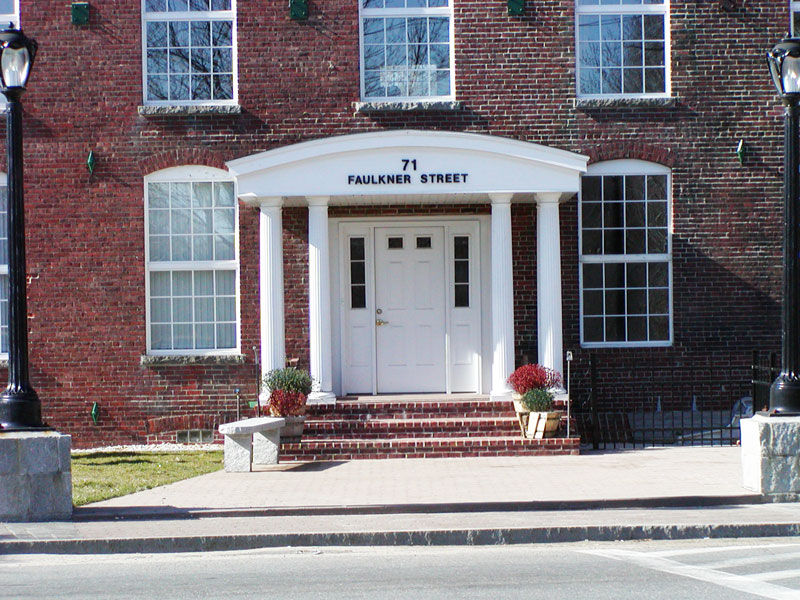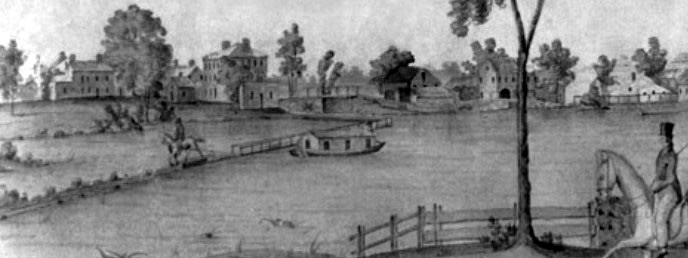


Middlesex Canal Association P.O. Box 333 Billerica, Massachusetts 01821
www.middlesexcanal.org
| Volume 48 No. 3 | April 2010 |
MCA ACTIVITIES
Please mark your calendars. Our Spring Walk will be held on Sunday, April 24th, departing from the museum soon after 1:30pm; our Annual Meeting will be held at the museum on Sunday, May 16th, beginning at 2:00pm. And the 8th Annual Middlesex Canal Bike Ride will be held on Saturday, October 2nd, meeting at Sullivan Square at 9:00am. See the Calendar, beginning on page 3, following, for more information on all of these. Also included in the calendar are meetings and tours, sponsored by other groups, in which you may want to participate. Please check our web site periodically, at the URL noted above, which sometimes lists additional canal-related events and topics potentially also of interest.
PRESIDENTíS MESSAGE
by Bill Gerber, President pro tempore
978-251-4971;
wegerber@gmail.com
Again, a hearty and sincere Thank You to all who have contributed to our annual appeal.
We are also grateful to Beverly Kenworthy of Peabody, Massachusetts for donating her late husband's large collection of canal related books to the Association for inclusion in our library. A New Yorker by birth, and advisor to corporations regarding their computer needs, Robert James Kenworthy was a canal enthusiast and visited many canals here and abroad.
To update you on Nolan, the MCA's longest serving president, he had a relapse in mid February which exacerbated the weaknesses in his left arm and leg. Recovery, even to the state it had reached after his stroke, has progressed at a slower than hoped for rate. Nolan and his wife, Joan, have decided to move west to an assisted living facility near Nolan's daughter's home in California. They are scheduled to depart for Sacramento, by train, in mid-April.
We have an urgent need to recruit volunteers to staff the museum for one or more of the four hour periods that it is open on each weekend day. Can you help? Please do. Betty Bigwood <gbchwilm at comcast dot net> will match you up with someone with good knowledge of the canal and its role in the growth and development of Boston and the towns along its route.
An equally serious need is to raise money to pay the rent to sustain our museum. All suggestions and assistance will be gratefully accepted.
Since the founding of the Middlesex Canal Association, the results of research into the history of the canal by many members and friends have been published in our newsletter, Towpath Topics. Rob Winters, our webmaster, has been posting past issues of TT on-line, thereby creating quite a good research resource. He has now reached the 75% level, 81 back issues are now on available at http://www.middlesexcanal.org/towpath, and 27 more are yet to come; Rob says "soon".
Traci Jansen held a successful children's workshop at the museum on February 18th. See her account of this project beginning on page 7. More recently, Traci has been negotiating to host a visit by a group of home-schooled children; and she has started initial planning for another teachers' workshop this summer.
Per Tom Raphael, a PDF copy of the Middlesex Canal Heritage Park Feasibility Study can be downloaded from the Northern Middlesex Council Of Government (NMCOG) web site (http://nmcog.org). The study was completed in 1980 by the Industrial Archaeology Associates (IAA) and was adopted on March 16, 1996 as the basis for the Middlesex Canal Commission's Master Restoration Plan. When mention is made of work being done to restore extant sections of the canal to public access and use, this is the plan by which the work is being done.
A short time ago, our bookstore sold out of Lewis Lawrence's manuscript on the history of the M'sex Canal. J.J. Breen took on the task of correcting the few typos that appeared in the first edition and getting a second edition printed. This effort has been completed and new copies are again available for sale in the bookstore.
From the Spring 2008 issue of Towpath Topics, Dave Dettinger's article about "The Canal that Bisected Boston" (aka the Mill Creek Canal), will be reprinted in a forthcoming edition of American Canals, the newsletter of the American Canal Society. Dave has been working with AC editor Linda Barth (ACS, CSNJ) to prepare his article for republication.
And that's about it for this issue.
Bill Gerber
TABLE OF CONTENTS
President's Message (Bill Gerber)
Calendar of Events
A Gala Event to Honor Tom Dahill (Betty Bigwood)
Endeavors in Education (Traci Jansen)
Letters First Published ... #4, by Sullivan (Howard Winkler)
Change (a.k.a. 'Turnover') Bridges (Roger Squires)
Scofflaws on the Canal (Bill Gerber)
Tour Digs Up the Past of Middlesex Canal (Jennifer Myers)
Lance Metz, National Canal Museum Historian, Honored
Miscellany
CALENDAR OF EVENTS
Middlesex Canal Association (MCA) and related organizations
First Wednesday: MCA Board of Directors' Meetings - The BoD meets, from 3:30 to 5:30pm, the first Wednesday of each month. Members are welcome to attend.
April 16-18, 2010: Pennsylvania Canal Society Spring Field Trip: upper grand section of the Lehigh Canal. Contact: Bill Lampert, <indnbll at yahoo dot com>, 215-262-5506.
April 17, 2010: Annual Douglas Memorial Hike and Dinner. Three different hike length options with bus transportation provided. Cumberland to Spring Gap area with dinner and evening program at the Orleans Volunteer Fire Dept. Dorothea Malsbary, 301-942-2528; <Programs at CandOCanal dot org>.
April 23-25 or April 20-May 2, 2010: "Bridging the Tuscarawas Gap" - See trail development along the Ohio & Erie Canal, restored toll house, Trenton dam and feeder & Lock 15 Park. Contact Larry Turner, 330-658-8344 or <towpathturner at aol dot com>.
Sun, April 24, 2010: MCA-AMC Spring Walk. Middlesex Canal; Joint with Appalachian Mountain Club; meeting time 1:30pm. The walk will originate from the Middlesex Canal Museum and Visitor Center in the Faulkner Mill in North Billerica. It will be conducted for 2-3 hours, rain or shine, over 3 to 4 miles of generally level wooded terrain and streets. The route follows the canal south of the Concord River. Sites to be visited include a guard lock, an anchor stone for the floating bridge which once carried the towpath across the river, and many stretches of canal, some still watered. No registration required, for more information: call walk leaders: Roger Hagopian 781-861-7868 or Robert Winters 617-661-9230; robert@middlesexcanal.org. For directions to the museum, see the notice for MCA's Annual Meeting, below. The Museum and Visitor Center, and the bookstore, will be open from 12 noon to 4pm.
Directions to the Museum/Visitors Center: Telephone: 978-670-2740.
By Car: From Rt. 128/95, take Route 3 toward Nashua, to Exit 28 "Treble Cove Road, North Billerica, Carlisle". At the end of the ramp, turn left onto Treble Cove Road toward North Billerica. At about ¾ mile, bear left at a fork. After another ¾ mile, at a traffic light, cross straight over Route 3A. Go about ¼ mile to a 3-way fork; take the middle road, Talbot Street, which will put St. Andrew's Church on your left. Go about ¼ mile and bear right onto Old Elm Street. Go about ¼ mile to the falls, where Old Elm becomes Faulkner Street; the Museum is on your left and you can park across the street on your right, just beyond the falls.
From I-495, take exit 37, N. Billerica, south to the road's end at a "T" intersection, turn right, then bear right at the Y, go 700' and turn left into the parking lot. The Museum is across the street.
By Train: The Lowell Commuter Line runs between Boston's North Station and Lowell's Gallagher Terminal. Get off at the North Billerica station, which is one stop south of Lowell. From the station side of the tracks, the Museum is a 3-minute walk down Station and Faulkner Streets on the right side.
May 1, 2010: Canal Walk/Ride. Join the Canal Corridor Association in Morris, IL for the third annual I&M Canal Walk or Ride Celebration. Walk one to five miles or bike ten to twenty-five miles during this fun, family event. Bring a group from your business or invite some friends and make it a team effort! Contact Katie MacKay, <reservations at canalcor dot org> or 815-220-1848.
Sun, May 16, 2010: Annual Meeting of the Middlesex Canal Association. This meeting will elect a new slate of Officers and Board Members. The speaker and topic are yet to be determined. The meeting will be held in the Middlesex Canal Museum and Visitor Center in the Faulkner Mill in North Billerica, beginning at 2pm.
Sun, May 16 - Annual Meeting of the Middlesex Canal Association. We will elect a new slate of Officers at this meeting. Following that, our speaker will be Dorit Lammers, author of the book "German Glass Blowers in Chelmsford" who, based on her book, will present a slide show and lecture about the Hirsch family, German glass blowers who worked in the Chelmsford Glass Works. They produced windowpanes for American households, still a rare and expensive commodity in the early eighteen hundreds. Their high quality window glass made Chelmsford's name well known in other parts of the country. The Middlesex Canal, which connected the Merrimack River with Boston harbor, played an essential role in the success of this enterprise. The meeting will be held in the Middlesex Canal Museum and Visitor Center in the Faulkner Mill in North Billerica, beginning at 2:00pm. For directions to the museum, see the notice for MCA's Spring Walk, above. The Museum and Visitor Center, and the bookstore, will be open from 12 noon to 4pm.
Sun, May 16. Blackstone River and Canal Walk. Moderate five-mile Sunday morning hike along the towpath of this historic river located 45 miles southwest of Boston in Uxbridge. Leader Bruce Wright, Co-Leader Kathy Moss. [This is an AMC Boston Chapter, Forty-Plus Committee event. Registration and possibly AMC membership is required. See MCA website for contact information.]
May 21-23, 2010: Canal Society of New York State Spring Field Trip: Champlain Canal and the PCB cleanup project at Fort Edward. Headquarters: Queensbury Hotel, Glens Falls, NY. Room rate: $99 plus tax; 518-792-1121. Check the web, www.canalsnys.org for updates.
May 22, 2010: CSNY, Dedication of restored Nine Mile Creek Aqueduct, Camillus Canal Society, Camillus, NY. Contact Dave and Liz Beebe, <dwbeebe at verizon dot net>.
June 19-20, 2010: Heritage Transportation Festival, Delphi, (IN) Canal Park. 1850 transportation, canal boat rides, high-wheel bicycles, carriage rides, etc. See the W&E web site at www.wabashanderiecanal.org, or contact Dan McCain at <mccain at carlnet dot org>.
September 19-24, 2010: World Canals Conference, Rochester, NY. Contact: www.worldcanalsconference.org. Post conference tours Fri, Sept 24. Check www.wccrochester.org.
Sat, October 2, 2010: 8th Annual Middlesex Canal Bicycle Ride. We will meet at Sullivan Square Station at 9:00am, following the route of the Canal 38 miles to Lowell, and taking the train back to Boston. Riders who leave the ride early can take the train back from Wilmington or North Billerica. For further information, contact Dick Bauer <dick.bauer at alum dot mit dot edu>.
October 1-16, 2010: Study tour of south German waterways. Contact Tom Grasso, www.canalsnys.org.
October 8-10, 2010: Pennsylvania Canal Society fall trip.
October 22-24, 2010: "River Boats, Pirates and Caves." Headquartered in Evansville, IN. Bus tour of southeastern Illinois, Cave In Rock, Garden of the Gods, Ohio River locks, Paducah, Kentucky flood wall murals (possibly Quilters Hall of Fame and the Civil War Museum) on Saturday. Friday tour of LST in Evansville, Sunday Wabash & Erie Canal in Warrick County Indiana. Carolyn Schmidt, 260-432-0279; <indcanal at aol dot com>.
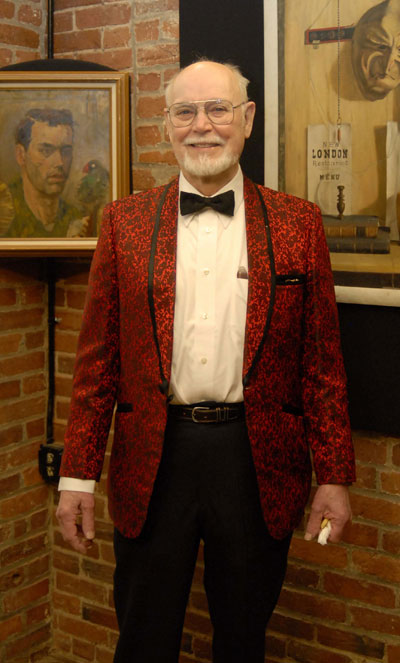 A Gala Event to Honor Tom Dahill
A Gala Event to Honor Tom Dahill
by Betty Bigwood
On Saturday, February 20, 2010 the Board of Directors of the Middlesex Canal Association honored Thomas H. Dahill, our Artist in Residence, with a festive Reception and Exhibition of his art at the Middlesex Canal Museum and Visitor Center.
When they began writing their book "The Incredible Ditch" Carl and Alan Seaberg asked Tom to illustrate it. The many sketches and watercolors he produced for the book provided the basis for the launch of the Museum in July, 2001. His two large murals were executed at home and brought up for installation. Tom provided the expertise and leadership, and a fair portion of the labor, to layout of the current floor plan. His art and his active and enthusiastic participation has advanced the knowledge and understanding of the Canal by thousands of visitors. His work for the Museum was volunteered and we can say without equivocation that the Museum would not exist without him.
Tom's talent also extends to areas other than historical re-enactment. His Exhibition of a variety of paintings brought in for the special occasion represents years of work. The Reardon Room was changed significantly by installing large white display panels hung by Tom, Alec Ingraham and J. Breen. His self-portrait, completed some fifty years ago sold that night. True to Tom's generosity he gave twenty five percent of the price to the MCA. There was a trompe l'oeil painting done years ago in the Museum School. Tom loves to swim and several of his recent paintings depicted water scenes from the gaze of a bottom swimmer. He has illustrated numerous books which were on display. What boundless energy!
Tom Raphael, looking very distinguished in his tuxedo, greeted guests as they arrived. Tom's family and friends traveled considerable distances to help him celebrate the occasion. Roger Hagopian played jazz piano in the background. David Dettinger explained the water lock to newcomers while others explained the displays. Wine and refreshments flowed. Alan Seaberg's granddaughters helped pass a variety of hors d'ouevers. Time flew!
Howard Winkler took charming photographs of the occasion and said he enjoyed the party so much he didn't want it to end! Tom's niece touchingly wrote in the Guest Book "how glad she was that He was her Uncle". Bill Gerber toasted Tom as a Renaissance Man – indeed he captured the essence of the Man.
A Toast
Ladies and gentlemen, may I propose a toast. Today, a scholar who acquires more than superficial knowledge about many different interests can be thought of as a "Renaissance Man".
Consider Tom Dahill. During WWII Tom served as an aerial navigator, he holds a degree in Chemistry from Tufts and is a graduate of the MFA School. He held a two-year Abby painting fellowship to the American Academy in Rome. He has taught studio arts and art history at the MFA School, Tufts University, and Emerson College.
He has produced many paintings, watercolors and pen drawings, and has illustrated a very significant number of books. Today he is an Emeritus Professor of Fine Arts at Emerson College. More locally, Tom is the source of most of the drawings and paintings in this museum; and of these, have you seen the two very large murals in the next room. He has taught countless children and other visitors about the canal. Please raise your glasses to an American patriot, artist and educator, our own artist-in-residence and friend, a true "Renaissance Man", Thomas Henry Dahill, Jr.
Tom looked the part – very handsome, dressed in a formal red jacket and black pants. He was smiling every time I saw him so we know he enjoyed the occasion. It couldn't have been for a nicer guy!
Endeavors in Education
by Traci Jansen
The MCA Education Committee reports ongoing progress with curriculum development and teacher and student workshop offerings. This Winter, a group of Wilmington and Billerica students enjoyed a morning at the museum boat building, role playing, working the locks, and painting a mural of the canal with our resident artist.
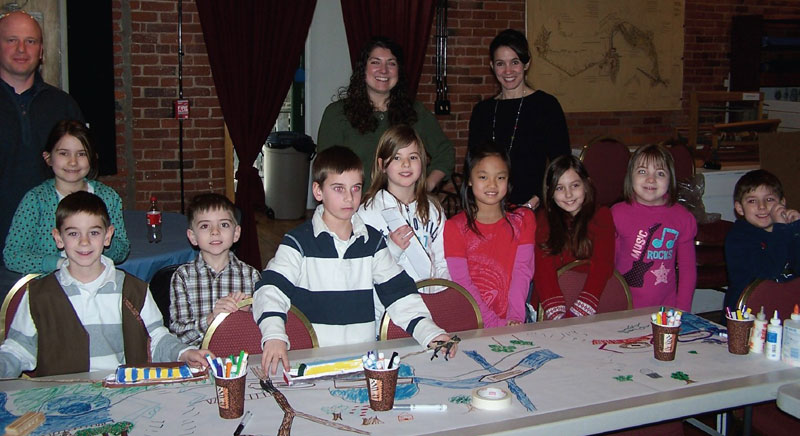
The museum will soon host four days of Wilmington third graders for a similar experience. This summer, teachers from schools along the old canal are invited to a driving tour of its path and remains with stops on Canal Street in Boston and Loami Baldwin's estate in Woburn.
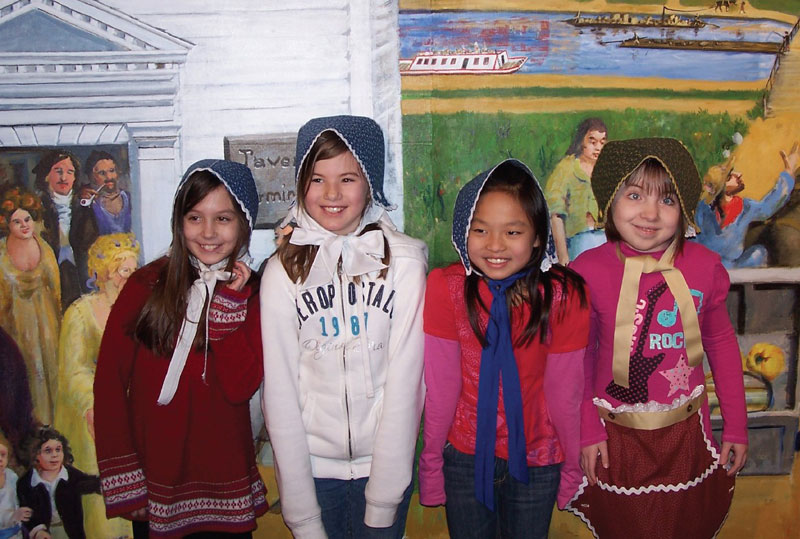
Funding for our education program is provided by a private grant through the JMR Barker foundation.
LETTERS, First Published in the Boston Daily Advertiser (1818),
in Answer to Certain Inquiries, Relative to the MIDDLESEX CANAL
by John L. Sullivan, Agent of the Corporation. No. IV
This is the fourth of five letters. One, two, and three were published respectively in the October 2008, April 2009, and October 2009 issues of Towpath Topics. The letters have been transcribed by Howard Winkler from an electronic facsimile found at the Tisch Library, Tufts University. Spelling and punctuation have not been changed.
Mr. Hale — Those proprietors of the Canal, who regard it merely as a property, and not as an instrument of business, to be made productive by measures of good policy, as well as by good management, will have inadvertently confounded the annual wages and support of the hired servants, clerks, and agents, with the expenses, of a temporary kind, incidental to this stage of progress; and may have blended those with such as recur from time to time, as the decay of the works will occasion. Nor will it have occurred, that another branch of attention to their interest, may, to increase the productiveness of this kind of property, require measures sometimes involving a temporary expense. But it should be remembered that a canal is not like a bridge necessarily to be used. It must afford a cheaper, more convenient, and as safe a mode of conveyance as the roads.
The ordinary expense on the Middlesex Canal, consists of the wages of 16 men, and three clerks, whose duties are distinct, and at certain stations, apart from the agent, and of his salary and commission; the whole amount is about 8000 dollars per annum.
The tenders are qualified and relied on to do most of the work, to keep their locks in order, and in the winter collectively, to do the repairs preparatory to the ensuing season. And in the summer there are a few labourers and carpenters occupied, especially in keeping up the bridges and banks, and assisting the tenders in heavy work requiring help.
The auxiliary locks and canals are separately managed by the same system, and with much regard to economy; but the question cannot be in a service of this kind, who will work cheapest; but who are to be had best qualified, most trust-worthy, and reasonable in expense at the same time.
— It is not then to the ordinary expenses of management that the proprietors or the public will attribute their present disappointment; but a recurrence to the facts already stated, will exhibit causes far more adequate, though temporary.
The facility of collecting the toll, by the present mode, is not completely understood.
When a raft is passing Bow Canal, the intendant while locking it through, enters a description of it in his book, and receives from the owner the best report he can get.
The same is done at Hooksett, six miles lower down the river.
At Amoskeig, while passing, the Intendant there goes on to the raft, examines, counts and measures it, as accurately as is practicable. This survey is entered in his book, the tolls calculated for each of the canals, and for such of the union locks as the kind of raft, and the state of the river make it necessary to use. If the raft is bound to Newburyport, the toll is paid in cash; if to Charlestown, a note is taken, and the property pledged as collateral security. On reaching Middlesex, a passport is given, descriptive of the raft, and attached to the manifest from Amoskeig. At the office in Charlestown, the settlement of the toll is made — if the owner does not sell immediately, he deposits his property in the booms. If it us partially taken out, the tolls of the upper canals are first paid, and as much towards the Middlesex, as amply covers the part removed. Thus the agent has it in his power to trace the progress of the business, and to see that all is finally collected as he settles the collection accounts periodically.
Boats ascending or descending have their loading ascertained at the entrance, and at each canal, as occasion may require. Each one carries a passport, to be produced at each lock, and penalties are annexed to the breach of the regulations. — The refusal of a passport, and the prompt institution of a suit before a magistrate when necessary, gives a sufficient control over the minds of those who use the canal.
The lock tenders are themselves under strict rules, and are obliged to facilitate the passage of the canal on a given signal, at the earliest and latest hours of light.
While the auxiliary Canals were building and completions of the Middlesex already mentioned, were going forward, it was expedient to anticipate with preparations the moment of their opening for use: For business does not naturally flow thro' a Canal any more than its waters — It must be conducted to it by motives of interest. At the commencement of its operation a Canal has to contend with the long established habits of the community. Guided by experience the people will not venture from their accustomed track, until they are shewn by those who have made the new and untried one, that is safer and better. Habit will then become as strong in this course, as in any other.
With this view as early as 1810 — I commenced on my own account and risk, the transportation of goods by water as far as the then state of the river would allow. And previously to its being fully opened to Concord, erected warehouses there, and at other places, where the principal roads diverge from the river into the country.
The Merrimack Boating Company being planned and incorporated, went on with no accession till recently, new associates have given it power and respectability, and it completes the whole system of operation, and gives to the Town and to the Country in that direction, the means of that reciprocation of benefits originally contemplated.
The company from the beginning has paid about 20,000 dollars in toll. In 1817, $9241,91 of which $4184,37 was to Middlesex.
There are other boats owned by individuals which carry to certain points lower on the river, and others solely employed in carrying wood and stone.
The nature of this accommodation will be perceived more distinctly on attending to the operation of it. A trader from any distance in the part of the Country we have described, comes here to make his purchases, without the expense and embarrassment of a team, capable of carrying but two tons. He feels assured whether he purchases two or twenty tons that on being duly entered at the Boston landing, it will, the same or following day be on its way, and in less time, in better order, than it could be carried by land; will meet his teams at Concord, or lay there in store till it is convenient to send, and at a little more than half the expense of land carriage. In like manner, freight down is entered and forwarded to its destination: — if ashes, butter, or provisions, to their respective Inspections. If the owner of cattle wishes to make the profits himself, on barreling his beef he finds a slaughter house, butcher and packers and salt at the landing: — the farmer who wishes to send his hay to the Boston market, finds the apparatus for screwing it at the company's Barn. If it is desirable to make a deposit of salt for winter trade, there is store room — there is the depository of lime and plaster for all that portion of our country, the latter in its way is passed through a mill, is pulverized and barreled for immediate use, or is carried up in the lump — It is sold in considerable quantities or exchanged for staves and other loading.
This branch of the canal business has not been without its difficulties; but experience will reduce its expenses, and render it sufficiently profitable, notwithstanding one third of the gross amount of receipts belongs in tolls to the several Canals.
While the improvements in the river were advancing, I devised the mode of applying steam engine specially for the purpose of towing boats and vessels on rivers and canals, for which a patent was granted after the controversy respecting it, with the late Maj. Fulton, determined in my favour, by the award of arbitrators appointed under the law of Congress by Mr. Munroe, the Secretary of State.
The experiments I tried in our harbour, on the canal, and Merrimack river, established its usefulness and its advantages, which are now extensively realized under this patent, in the State of Georgia.
The heavy engine I procured from Philadelphia, and its perpendicular action, were very unfavorable to boats of the size and strength of those we use on the canal. After experimental operations in the course of three summers, and various modifications of the power — the discovery of much aid from the reaction of the wake of the boats, I was from these circumstances obliged to suspend my operations on the Merrimack, until I should contrive or procure a horizontal action of the engine. In this I have succeeded — yet I am better satisfied with the rotary engine invented by Samuel Morey, Esq. whose patent I have purchased for navigation. An engine of this kind has lately been erected at the navy yard in Charlestown, which carries a saw 120 strokes a minute, through a log one foot diameter. It is a very small engine, and as yet without its condenser. The stroke of the cylinder is but one foot, and the diameter nine inches. There is only one boiler 14 feet long, and three feet diameter. One part of the invention is an internal covering of the furnace, by which the steam is generated with uncommon rapidity.
The rotary motion prevents all jarring — supplies the place of a balance wheel — its strain is all within itself — it is not liable to get out of order — it has none of the usual geer and valves — and its simplicity is such, that any common hand may manage it. The lightness and compactness of this engine fits it peculiarly for boats. It contains the principles tested by experience, and unites all the usual sources of steam-engine power.
To this we may add some discoveries by the same gentleman in the fuel of an engine, consisting of several methods of decomposing part of the steam to produce inflammable gasses by a process that combines the principles of combustion (oxygen and hydrogen) with the carbon of tar, rosin or turpentine, so that a great source of flame is had in a small compass, at little expense, and perfectly manageable.
An exact description and print of this machine will be shortly given to the public. The connection of that improvement with the future business of the Merrimac, to promote and encourage which Legislature of New-Hampshire has adopted a liberal policy, may be my excuse for this short description of it, and digression from the subject of inquiry.
You will allow me in a future and early communication, to conclude with some remarks on the prospects of the canal, as they are presented to my view, in immediate relation to the proprietors, and in remoter relation to the public.
J. L. Sullivan
Change (a.k.a.'Turnover') Bridges
from Dr. Roger Squires (through Bill Gerber)
In the Spring, 2008, issue of Towpath Topics there was an article about how the Middlesex Canal's towpath was changed from one side of the canal 'channel' to the other. The article included drawings to illustrate how the tow animal would move so that it was unnecessary to detach the towline while negotiating a change bridge.
Recently, the British member of the American Canal Society's Board of Directors, Dr. Roger Squires, provided the following photo, which provides an excellent illustration of the path provided by a change bridge. In Dr. Squires words: "the bridge offered the direct route for the towing horse to move over the canal without unhitching the tow rope when the towpath changed sides".
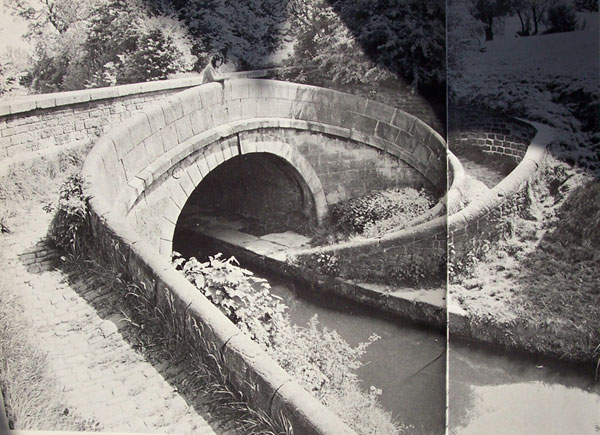
Canal 'Change/Turnover Bridge' at Congleton on the Macclesfield Canal, UK
There are two principal differences between the English canal bridge shown, and the bridges used on the Middlesex Canal. As shown in the Spring '08 issue drawings, the Middlesex bridges were dual use, i.e., they served the normal public access function of most bridges, as well as the change bridge function where needed; whereas the bridge shown is a single purpose change/turnover bridge. Also, the Middlesex bridges were fabricated (probably at the mill in North Billerica), transported to and set up on site; and, as such, were of much lower-cost construction.
Scofflaws on the Canal
by Bill Gerber ©
I submit that Captain Silas Tyler, who skippered the Packet Boat "Governor Sullivan", was a scofflaw! He routinely exceeded the speed limit for that class of vessel.
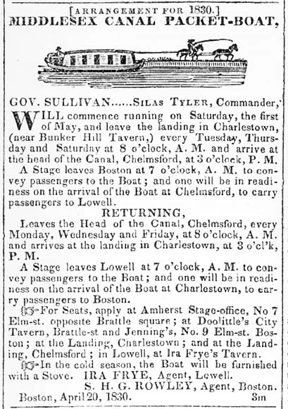 By regulation, the speed limits on the Middlesex Canal were set at 1½ mph for rafts and bands of rafts, 2½ mph for luggage (freight) boats, and 3½ mph for Packet boats. But, in those days, who had a speedometer? Likely, in practice, rafts (and bands of rafts) proceeded at the walking pace of a pair of oxen, the type of 'critter' usually hired upon arrival at Middlesex Village to draw the rafts down the canal. And similarly, luggage boats (freighters) probably moved along at the normal walking pace of a horse, the type of 'rent-a-critter' usually hired to tow them. But what about the Packets? Did they really proceed at 3½ mph? And, whatever the speed, what impact did that have on the canal and on how their tow horses were used?
By regulation, the speed limits on the Middlesex Canal were set at 1½ mph for rafts and bands of rafts, 2½ mph for luggage (freight) boats, and 3½ mph for Packet boats. But, in those days, who had a speedometer? Likely, in practice, rafts (and bands of rafts) proceeded at the walking pace of a pair of oxen, the type of 'critter' usually hired upon arrival at Middlesex Village to draw the rafts down the canal. And similarly, luggage boats (freighters) probably moved along at the normal walking pace of a horse, the type of 'rent-a-critter' usually hired to tow them. But what about the Packets? Did they really proceed at 3½ mph? And, whatever the speed, what impact did that have on the canal and on how their tow horses were used?
The question arises because the length of the trip was about 27¼ miles, yet an advertisement for travel by Packet, in 1830, claimed the boat, the Governor Sullivan, left Charlestown (or Middlesex Village) at 8am and arrived at Middlesex Village (or Charlestown) at 3pm; and vice versa.
So, if a Packet had to cover 27 miles in seven hours, how fast did it have to go? That's an easy arithmetic problem 27 ÷ 7 = about 3.9 mph; oops, that's a wee bit faster than 3.5 mph; but perhaps no one noticed.
But that's only part of the story. There were 20 locks along the canal and the Packets had to negotiate 16 of them along the 27 mile trip; but of course, two were guard locks that may even have been left open at normal levels of the Concord River, leaving 14 locks of consequence. What portion of the seven hour travel time was consumed negotiating the locks?
In 1829, Judith Tuck, traveling with her husband and taking her first trip on the Middlesex Canal, penned a letter to a friend to describe her new experience, and did so in a poetic form. (See the folklore article in http://www.middlesexcanal.org/towpath/towpathtopicsOct2009.htm.) At one point she wrote: "When we had reached to Woburn town - There we all stepped out on the ground - Had to pass over Locks all near together - Then we walked on one with another. It took them more than half an hour".
Mrs. Tuck was, of course, referring to the three two-lock staircases, six locks in all, that transited the high steep slope north of Horn Pond. Six locks in "more than half an hour" - that's something more than five minutes per lock. How much more? Six minutes? Seven? Eight? We don't know. (But Mrs. Tuck did comment on having time to dine on food the passengers brought with them and to take a tour.) Just to make the numbers easy, let's choose an average of 6½ minutes per lock for the 14 locks. This way it would have taken about 90 minutes to negotiate them all (14 locks x 6.5 minutes per lock = 91 minutes).
That's an hour and a half, which appreciably reduces the time available to travel the 27 miles, meaning that the speed of travel had to be considerably faster than 3½ mph - 27/5.5 = almost 5 mph. This was at least a fast walk for a horse, perhaps a trot; and it would definitely have been noticed.
But something more happens at this speed. Below 3½ to 4 mph, the bow wave from a boat simply rises up and descends against the side of the canal with little effect on anything. But around 4 mph and above, the bow wave begins to "cup", and this tends to scour the bank; not much perhaps, but a little each day. This was the principal reason 3½ or 4 mph was, and still is, cited as a maximum speed on a canal. Obviously the Packets could not make their seven hour trip time without effecting a little damage. But perhaps one boat each day was considered acceptable.
The foregoing are the principal factors defining the speed at which the Packets traveled. But others would also have influenced it. One of the canal regulations stated that boats (and Packets?) ascending toward the summit level (i.e., the Concord River Crossing) had priority over boats and rafts descending from the summit. Thus, boats heading toward Middlesex Village would have had priority for about the first 22 miles, but would have been required to yield for the last five miles of the 27 mile trip. And on the return, the same boat would have had priority for the first five miles but would have yielded for the last 22. Did this also pertain to the Packets, or did they retain priority throughout? Neither the regulations nor the historical record tell us.
Another regulation stated that rafts and bands were not permitted to pass other rafts or bands traveling in the same direction; luggage boats, were not permitted to pass other luggage boats, but could pass rafts and bands; and Packets were allowed to pass rafts, bands and luggage boats. In the act of passing, the lower priority craft (raft or boat) would have moved to the berm side of the canal, its tow animal to the outside of the towpath, and the towline between them slacked, but not detached, so that part of it laid flat on the towpath and the rest sank to the bottom of the canal. The higher priority craft would then pass between them with its tow animal stepping over the slacked towline of the craft it was passing, and the boat or Packet would float over the sunken portion. This process was completed fairly quickly but likely imposed some small loss of time on both craft each time it was executed.
There were a fair number of points along the route where the canal was constrained to one way traffic. These points included: bridge crossings, of which there were 48; aqueducts, of which there were eight; and locks, of which there were 20, 14 of which were normally of consequence to the Packets. None of these one-way stretches were very long; at 188 feet as initially built (later shortened to 40 feet), the Shawsheen Aqueduct was the longest. But if another boat was coming through any of these narrow sections, the Packet's tow horses would have to at least break stride, and if a band of rafts was passing through, even the Packet would need to stop and wait, if only for a short time.
There's not much of a current on a canal; think of it as a succession of independent levels, with chambers (locks) between the levels that could be filled from the upper level or drained to the lower, and so, excepting leakage or overflow, the only time water is added to or removed from a level is when a raft or boat negotiates a lock. Thus current is not likely to have had any appreciable effect on the speed of the Packet.
The foregoing encompasses about all the factors of greater or lesser significance affecting the speed at which the Packets traveled. What does this say about how the tow horses were used?
Little has been found in the historical record that sheds much light on either this or any related questions. The two relevant images that do exist might even contradict each other. The first is the advertisement shown above (for the Packet Governor Sullivan) which suggests that two horses were used and they were harnessed in tandem rather than side-by-side (a fairly common practice on canals). However, a circa 1825 painting of a Packet (possibly the George Washington), below, shows a single horse in use.

Excerpt from a watercolor painted by Jabez Ward Barton, ca. 1825, entitled View from William Rogers House.
Shown, looking west, is a packet boat, possibly the George Washington, being towed across the Concord River
from the Floating Towpath at North Billerica.
On the other hand, these images may not be in conflict. The advertisement shows a flat-roofed Packet with five windows per side, whereas the painting shows a peaked-roof, three-window Packet. While this is hardly definitive, either artist may have taken "artistic license", it does suggest that the Sullivan may have been a somewhat larger boat than the Washington.
And there's more; as noted in Lewis Lawrence's manuscript, an entry in the Baldwin family papers suggests that "Passage boats between Boston and Middlesex Village took 12 hours to go up and 8 hours to return." Considering discussions above, there are no obvious reasons that would account for this time difference. But since most of the Baldwin Family's papers tend to relate to the early years of the canal, it may be that the Packets were operated differently in the latter years than they were in the beginning.
The historical record states that passenger service commenced when "Mr. Wardwell, with the boat Washington, set from the Beachum Landing in Charlestown for the head of the Canal for the first time, Augt 22d 1804.
But, except for part of the first decade of operation, Packets were towed by whatever company contracted to operate them, and that company provided the horses. Since the Packets traveled at 3.5 mph, I assume this was the pace of a horse at a fast walk, these horses may have been "tuckered out" by the time they reached midway along the canal and if so, may have been swapped out when they reached Tay's Tavern, a known horse exchange station near the Wilmington-Woburn line. For a while I wondered if they might have been swapped out in North Billerica (near the floating towpath), at Tay's, and again at Horn Pond House. The "skeletal evidence" available now points to just one swap, i.e., at Tay's.
Given that the company which operated the Packet was required to provide four horses (as spelled out in an 1827 contract agreement), my thought is that two Packet tow horses started out in Charlestown and towed as far as Tay's Tavern, where the second two replaced them for the rest of the journey to East Chelmsford. These second two were rested over night and then began the trip back south. At Tay's, they were swapped for the first two, which had started the trip the day before, and these completed the trip back to Charlestown, where they were rested over night.
Tour Digs Up the Past of Middlesex Canal
by Jennifer Myers; <jmyers at lowellsun dot com>
The following article appeared in the April 28th, 2008, issue of the Lowell Sun. It is reprinted here with permission of the author.
WILMINGTON — George Washington was enjoying his second term as president of the United States when construction began. There were no trains, no trucks. "It was pickaxes, shovels and wheelbarrows," Betty Bigwood, of Wilmington says of the country's first major engineering project and one of the earliest known uses of eminent-domain law, the Middlesex Canal.
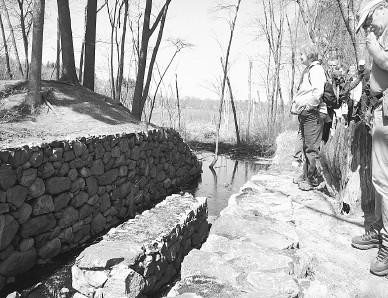
Group members tour the remnants of an aqueduct for the
Middlesex Canal at Maple Meadow Brook in Wilmington on
Saturday. (Sun Photo/Jennifer Amy Myers)
The engineers of New York's famed Erie Canal visited to see how it was done before attempting to build their own. Civil War hero Gen. Robert E. Lee came to experience the canal.
On Saturday afternoon, 60 people from all over the region strolled into the woods off Route 38 and walked nearly two miles in the now dry canal bed and high up on the leaf-covered berms, once essential in keeping the water contained.
The annual walk is sponsored by the Middlesex Canal Association, a group committed to education and preservation of the canal.
The engineering marvel once ran 27.4 miles, from Boston's Charlestown section to Lowell. It was the primary route for transporting goods from Boston to the Merrimack Valley and into New Hampshire, and vice versa, for about 50 years upon its opening in 1804.
At its peak, the canal carried 6,000 boats per year, floating everything from hops to beef, butter, lumber and the stone that was used to build Boston's Faneuil Hall.
Today, about 10.5 miles of the canal are still visible from Winchester to Lowell.
"Whenever I come here, I always run my fingers through the grooves," Robert Winters of the Middlesex Canal Association says as he kneels by an enormous boulder along the canal's path.
He points out the inch-deep grooves in the rock, scars from years of canal ropes rubbing against the stone as the boats turned to adjust to the sharp curve in the path.
Winters equates his ritual to that of Roger Clemens rubbing the bronze plaque of Babe Ruth before taking the mound at Yankee Stadium.
He fell in love with the canal by chance, finding some information about it in a book about interesting bike rides. "It has become an obsession," he said. "You just want to discover more and more."
Saturday was the first time Gloria Cocoran of Wilmington had walked the canal bed. "I thought it would be a nice way to find out about the history of the town," she said. "What is fascinating is that it is right here in people's backyards, and they probably don't know it."
The group reaches Maple Meadow Brook, an impressive site. It once hosted one of the canal's aqueducts. Winters explained that because water does not flow uphill, the canal's engineers had to work around the topography in their midst. To pass over the brook, a basin was constructed to act as a water bridge over the existing water, keeping the canal flowing uninterrupted.
Elaine Tierney and Nellie Miller, originally from Australia and Argentina, respectively, came from Waltham for the walking tour. "They really have a passion for this," Miller said of the members of the Middlesex Canal Association. "It was very informative." Tierney added that, although the walk was a little longer than her legs wanted to go, she enjoyed learning the history and was impressed that it was so well-preserved considering the extensive development surrounding it.
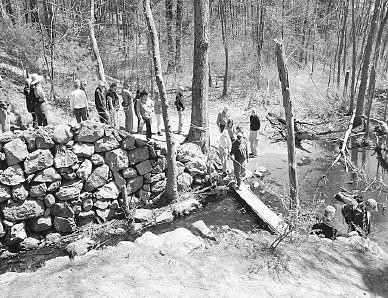
The group tours the Maple Meadow Brook area of the
Middlesex Canal in Wilmington. (Sun/Jennifer Myers)
The canal system that made the construction of much of the city of Boston possible was rendered obsolete by the railroad in the early 1850s. Railroads could run year round and throughout the night. It was also a more efficient way to transport large quantities of goods and did not require the muscle power of animals, who were used to pull boats through the canal.
But thanks to the members of the Middlesex Canal Association, the history of the canal will never be lost.
For more information, visit www.middlesexcanal.org.
Lance Metz, National Canal Museum Historian, Honored
The Pennsylvania Federation of Museums and Historical Organizations has presented the Professional Award to Lance Earl Metz, Historian of Hugh Moore Historical Park and Museums. The award recognizes Mr. Metz's strength of commitment and the institutional and community impact of his many activities.
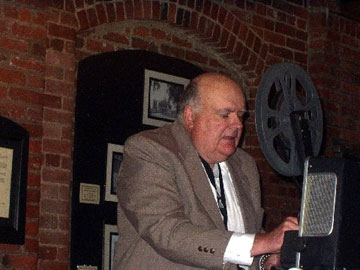 Over the past 30 years, Lance Metz has contributed more than any other person to the preservation and interpretation of canal history and its significance to the in history of the Lehigh River industrial corridor. He has been the go-to historian for local media, the anchor for documentary storytelling, and a fount of all things historical in the greater Lehigh Valley.
Over the past 30 years, Lance Metz has contributed more than any other person to the preservation and interpretation of canal history and its significance to the in history of the Lehigh River industrial corridor. He has been the go-to historian for local media, the anchor for documentary storytelling, and a fount of all things historical in the greater Lehigh Valley.
As Historian for Hugh Moore Historical Park and Museums in Easton, Lance has shared his passion for industrial history with millions of visitors. His work extends beyond developing programs, exhibitions, and collections for the National Canal Museum, however; Lance has also written, researched, consulted, and lectured extensively.
At his core, Lance is a teacher with a savant's attention to detail. After graduating magna cum laude with a B.A. in history from Moravian College in Bethlehem, he taught social studies in Susquehanna, and has lectured on local history at both Lafayette College in Easton and Moravian College. He instituted a series of public lectures, films and symposia in 1979, which continues to this day. He expanded his education by earning an M.A. in history from the University of Maine at Orono, and completing the museum studies program at Lehigh University in Bethlehem.
A quote from Easton Mayor Sal Panto, Jr., sums up Lance's career with the National Canal Museum: "What started out in Lance's garage as a small library has become an internationally-recognized Museum, a unique and invaluable asset to our region's quality of life, its economic development, and our future. He has become a de facto favorite son and historian-in-residence."
A reception honoring Lance was held by the National Canal Museum at the Grand Eastonian Suites Hotel on December 10, 2009.
MISCELLANY
Masthead - Excerpt from a watercolor painted by Jabez Ward Barton, ca. 1825, entitled View from William Rogers House. Shown, looking west, may be the packet boat George Washington being towed across the Concord River from the Floating Towpath at North Billerica.
Back Page - Excerpt from an August 1818, drawing of the Steam Towboat Merrimack crossing the original Medford Aqueduct (artist unknown).
Web Site - As you may have noted from the masthead, the URL for the Middlesex Canal Association's web site is http://www.middlesexcanal.org. Our webmaster, Robert Winters, keeps the site up to date, thus events and sometimes articles and other information will often appear on there before we can get it to you through Towpath Topics. Please do check the site from time to time for new entries.
Museum & Reardon Room Rental - The facility is available at very reasonable rates for private affairs, and for non-profit organizations' meetings. The conference room holds up to 60 people and includes access to a kitchen and rest rooms. For details and additional information please contact the museum at 978-670-2740.
Canal Game and Puzzle - The National Canal Museum has made a canal related game and a puzzle available on their web site http://www.canals.org/funandgames/. These include: a Boat Captain's Game - Can you run a canal shipping business successfully? And a Canal Lock Puzzle - would you know how to construct a canal lock and make it work? Give them a try.
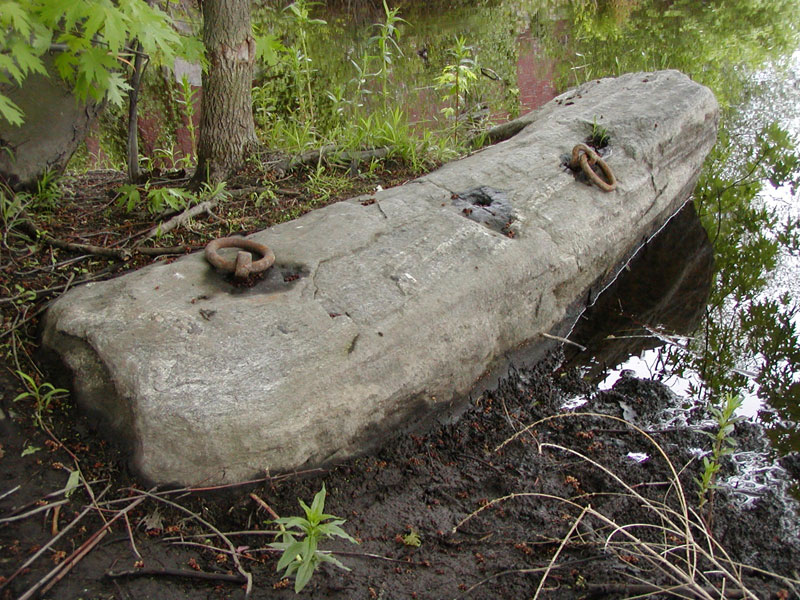
Anchor stone of the Floating Towpath at the Concord River in North Billerica,
one of the featured attractions on the April 24, 2010 Spring Walk.
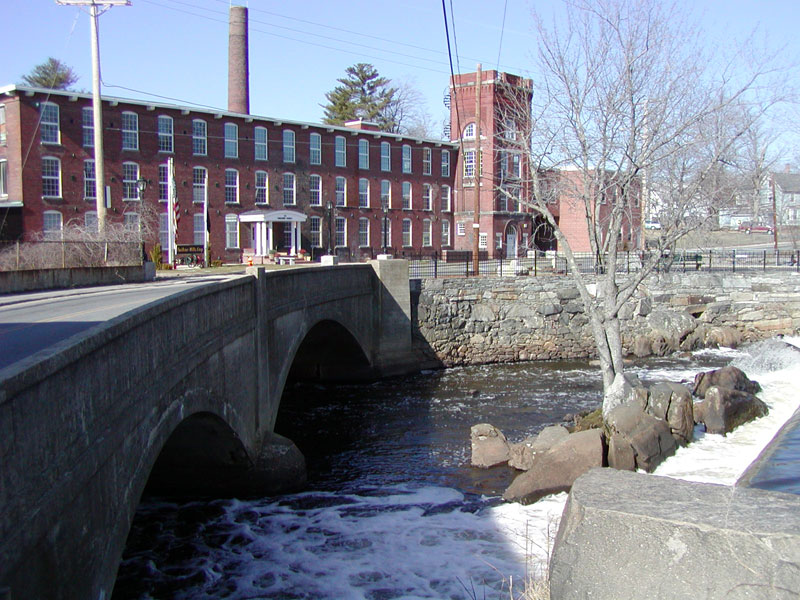
The Middlesex Canal Museum & Visitors Center in North Billerica at the Faulkner Dam
